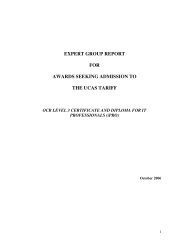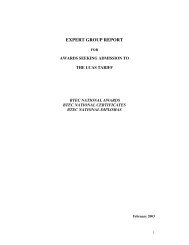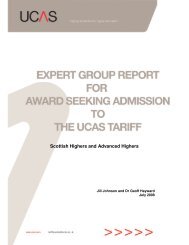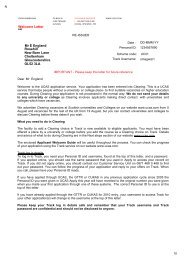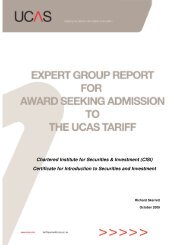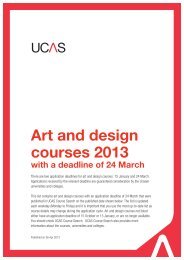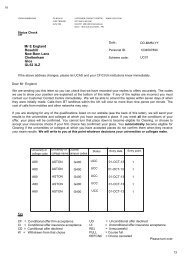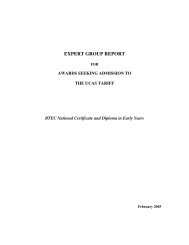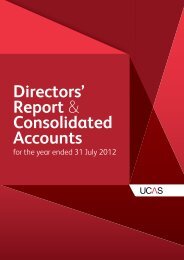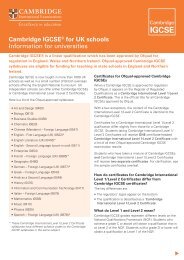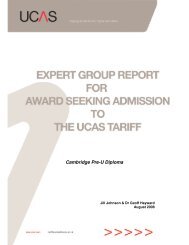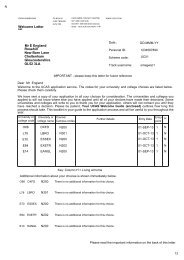International qualifications 2013 (pdf) - CUKAS
International qualifications 2013 (pdf) - CUKAS
International qualifications 2013 (pdf) - CUKAS
You also want an ePaper? Increase the reach of your titles
YUMPU automatically turns print PDFs into web optimized ePapers that Google loves.
Qualifications currently offered<br />
language (English), social studies/science/vocational education,<br />
and second foreign language/Chinese characters and classics<br />
– all are optional (students select subjects required by the<br />
colleges they wish to attend). The new CSAT adopts two ways<br />
of marking: one is raw mark and the other is standard mark.<br />
Subject areas (standard) Full (raw) mark Range<br />
Verbal 100 0 – 200<br />
Mathematical 100 0 – 200<br />
English 100 0 – 200<br />
Humanities and social studies or science 50 0 – 100<br />
or vocational studies<br />
Foreign languages 50 0 – 100<br />
Kuwait<br />
EVALUATION<br />
Shahadat-al-thanawia-al-a’ama (General Secondary School<br />
Certificate)<br />
Acceptable at 60% or better in lieu of GCSE on a subject for<br />
subject basis (except English language).<br />
Would need to be supplemented by GCE A levels, Scottish<br />
Highers or Advanced Highers, or a bridging course.<br />
GRADING SYSTEM<br />
The grading varies between subjects; the maximum and<br />
minimum marks per subject are shown on the certificate. The<br />
main Grading System generally used by HEIs is:<br />
Grade Percentage Result<br />
A 100 – 90 Excellent<br />
B 89 – 80 Very Good<br />
C 79 – 70 Good<br />
D 69 – 60 Pass<br />
EDUCATION SYSTEM<br />
Education in Kuwait is compulsory from the age of six to 14,<br />
following a 5+4+3 system – five years elementary, four years<br />
intermediate and three years at high school. Intermediate<br />
education culminates in the Intermediate School Certificate. To<br />
progress to secondary education, students must achieve a<br />
minimum of 50% in Islamic education, Arabic, English<br />
language, mathematics, science and social studies. Secondary<br />
schooling lasts for three years, with all final three years being<br />
streamed. The General Secondary School Certificate is awarded<br />
provided students achieve the pass mark of 50% in all<br />
subjects. Arabic is the medium of instruction and English<br />
language is compulsory throughout school education,<br />
commencing in the first grade.<br />
There are numerous private schools in Kuwait which, while not<br />
free, are generously subsidised.<br />
ACCESS TO HIGHER EDUCATION<br />
Kuwait has one university, several technical schools, with private<br />
universities recently established. Admission to the university is on<br />
the basis of the General Secondary School Certificate. Individual<br />
departments set their entry requirements in the examination as a<br />
whole (eg 75% in medicine), and in addition require a competitive<br />
university entrance examination. The bachelor’s degree would<br />
usually take four years, except in engineering and pharmacy (five)<br />
and medicine (seven).<br />
Latvia<br />
EVALUATION<br />
Atestāts par vispārējo vidējo izgl ī t ī bu (Certificate of General<br />
Secondary Education)<br />
May be acceptable for entry to higher education, with the exception<br />
of English language skills, which should be tested separately.<br />
Considered to be comparable in standard to GCE AS/Scottish<br />
Higher.<br />
GRADING SYSTEM<br />
Centralised exams are marked A – F. For HE accession, usually<br />
grades A – D are needed. In general, the grading system for<br />
subjects appearing on the Certificate of General Secondary<br />
Education (Atestāts par vispārējo vidējo izgl ī t ību) is as follows:<br />
10 izcili (with distinction)<br />
9 teicami (excellent)<br />
8 ,Ioti labi (very good) A<br />
7 labi (good) B<br />
6 gandrīz labi (almost good)<br />
5 viduvēji (satisfactory) D<br />
4 gandrīz viduvēji (almost satisfactory) E lowest pass mark<br />
3 vāji (weak)<br />
2 ,Ioti vāji (very weak)<br />
1 ,Ioti, ,Ioti vāji (very, very weak)<br />
The mark 8 indicates that the knowledge and skills acquired<br />
correspond fully to the expected maximum level. Marks 9 and 10<br />
are evidence of knowledge and skills substantially higher than<br />
expected at the appropriate level of learning and are therefore<br />
somewhat like A+ and A++.<br />
EDUCATION SYSTEM<br />
Two year compulsory pre-school education is provided from the<br />
age of five. Nine year compulsory basic education begins at age<br />
seven, with four years of primary education, followed by five<br />
years of lower secondary education.<br />
The language of instruction at basic level is either Latvian or<br />
Russian. At age 16, after completion of compulsory education,<br />
students may choose to continue education at upper secondary<br />
level. There are two types of upper secondary education<br />
programme; general secondary and vocational secondary<br />
education and training programmes. The compulsory curriculum<br />
of three-year general secondary schools (vidusskola, ‘gimnāzija),<br />
determined by the National Standards, is available in the following<br />
profiles: general comprehensive; humanities/social;<br />
mathematics/natural sciences/technical; vocational/professional<br />
(arts, music, business, sports). General secondary education is<br />
aimed at students wishing to pursue their studies to HE level, and<br />
comprises eight compulsory and three to six elective subjects<br />
according to the requirements of the chosen profile. Upon<br />
graduation, students have to take at least four centralised<br />
national school leaving examinations. Since study year<br />
2008/2009 graduates must also take a mandatory centralised<br />
state exam in mathematics. The Certificate of General Secondary<br />
Education (Atestāts par vispārējo vidējo izgl ī t ību) and a certificate<br />
of the centralised exams passed detailing scores is awarded to all<br />
students who have received passing final marks in all the<br />
subjects studied according to their chosen profile, as well as a<br />
positive assessment in the national examinations.<br />
Vocational education and training programmes have also been<br />
developed, with the majority of schools providing three- and fouryear<br />
vocational education and training programmes at upper<br />
secondary level. Students of four-year programmes have the<br />
opportunity to combine the acquisition of vocational <strong>qualifications</strong><br />
INTERNATIONAL QUALIFICATIONS 35



